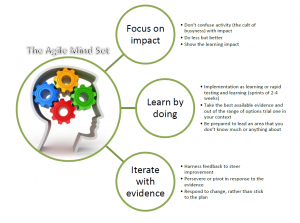Change how we change
Guest Blog: Joy Milward
How could 2017 be your highest impact year yet? Are you set up for this? Or are you activity focussed?
Exhaustion without traction
As a school principal I always felt busy, busy, busy but the rubber wasn’t necessarily hitting the road. Do you ever feel this way about your work? I began to understand ‘crazy busy exhaustion without traction’ after I attended a masterclass facilitated by Dr Simon Breakspear on the subject of change leadership: How to lead meaningful progress despite complexity and resistance.
The urgency to improve
I understand the urgency of change in terms of improving the achievement, engagement and wellbeing outcomes for all learners. However, improving student outcomes and professional practice is far more complex and challenging than I’d ever imagined. Things keep moving on the team as we’re trying to change and change is not a straight smooth pathway – people just don’t behave in the ways we would like and when! The history of formative assessment is a ‘no traction’ case in point made strongly by Breakspear.
From Benjamin Bloom in 1967 to Dylan Wiliam (Inside the Black Box) in 2005 to Hattie (Visible Learning) in 2014 – how is it that we’ve known this stuff for nearly 50 years but still feedback is not yet routinized in the practice of every teacher in every classroom every day? Strange isn’t it that formative feedback accelerates learning to a dizzying effect size of 0.73 and yet, garnering a critical mass of teachers that work daily in Hattie’s ethereal ‘blue zone’ of > 0.69 is proving elusive…
Knowing what is not the same as knowing how
Change when it comes is often superficial – all the right language but not the deep understanding that sustains change. Breakspear explains shallow change as an outcome of some common change errors. For example, purchasing an intervention package or outsourcing teacher professional development to fix a perceived problem without evidence or a theory of action. Signing up for the next innovation and pursuing too many improvements at once can also lead to thin knowledge acquisition. Teachers return to school enthused by new ideas and a bag of tricks but default back to the ‘tried and true’ and what works for them rather than ‘what works best’ for the learner.
Changing how we change

How to lead meaningful progress despite complexity and resistance
The short answer, according to Breakspear is that we need to change how we change and in the process account for human behaviour and engagement in our ‘perfect plans’. He’s not alone of course in this view and echoes Fullan with respect to clarity and sustained focus on a small number of core priorities, i.e. High order learning outcomes in reading, writing and number.
Key considerations for shifting behaviours – ‘super targeted capacity building’
- Build from what people are doing
- Make it easy by choosing the right starting point
- Trigger the right sequence of small steps
- Create success momentum and harness the motivation wave
- Shape the environment and provide the right tools to shape the behaviour, e.g. learning to use data requires ready access to data
- Make it social and fun – use the group to change the group

